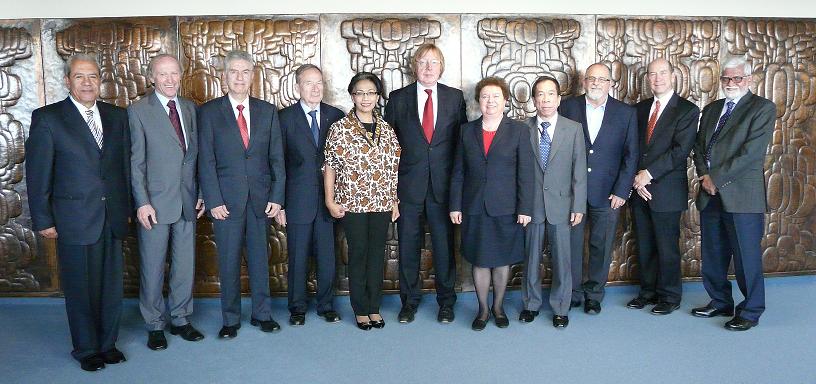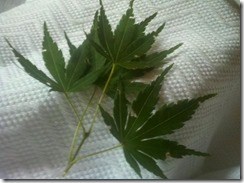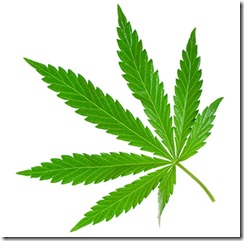
January 2, 2014
The following synopsis which I have found across the internet and put together here pretty much sums up the value of our “legalization” initiatives, whether they be “anti-prohibition”, tax and regulate, Repeal, ‘…”my God given right!”, or “Damn, we are all a bunch of fools to think that prohibition has ended…”.
With the passage of the new recreational and medical cannabis use laws in Colorado and Washington alongside all of the other “medical cannabis” states, everyone is/was jumping for joy at midnight on the 31st of December 2013. Prohibition has ended they proclaim, yet still remains illegal at the Federal and U.N. levels. The U.N. has already jumped on the bandwagon prior to the new year to make sure that Uruguay’s legalization was “in violation of international law”.
The Executive Branch of our U.S. Government seems to be just sitting back and watching, never giving a clear indication of what they will (or won’t) do. In fact, they just do not seem to be doing much of anything anymore with the exception of disagreements on what should be done.
Maybe, just maybe it is because they know something we may not. Maybe, they know that we are truly walking in the age of the NWO and the Global takeover by the U.N. It has already been written in stone and now we just sit back and watch what is going to happen. The U.N. is in control. The U.S. is not. The U.N. owns the World. We do not. No one owns anything, anywhere, anymore. Including the right to our own bodies and minds. The U.N. does. Even the thought that we actually had a chance to control our own lives is not very lucid. The U.S. and every other country within the U.N. are incorporated businesses with “us” as the “stock certificates”. Here are a few links to information on that:
Moving right along, New Year’s Eve 2013 will be one for the history books. Though I doubt actual hardcopy books will exist very much longer and the history can now be changed at the tap of a keyboard, so what that is worth I am not sure. But I know I sure feel sorry for the people who are out there actually believing that they have accomplished anything with their legalization antics. We have all led ourselves into a hole. I damn sure hope it is not too late to climb out of it.
So hear my happy New Year’s Song,
I saw it coming all along,
Yes I did, I know I did,
I sure the Hell saw it coming before YOU did!
So now your free, or so you think,
To smoke your pipe and drink your drink,
The Bell’s were ringing the whole damn time!
Why did you not listen?
Why did you not try?
To educate the masses, by pointing a finger in their eye?
Why did we wait so long,
That the whole damn illusion of freedom,
Flew by, said goodbye, and then was fucking gone?
@SMKRIDER
March 30, 2005
United Nations biosphere reserve land grabs
By Nathan Tabor
What do the Statue of Liberty, Independence Hall, and Monticello have in common? The average American with a smattering of historical knowledge might say that those historic sites are all symbolic of America’s unique heritage of freedom.
Monticello, of course, was the home of Thomas Jefferson, the author of the Declaration of Independence. That document (as well as the U.S. Constitution, later) was signed in Independence Hall. The Statue of Liberty memorializes the free nation under God that those founding documents created.
What about the Great Smoky Mountains, Yellowstone Park, and the Grand Canyon? Well, these priceless natural resources are all managed by the U.S. National Parks Service. They are among the most frequently visited natural recreation areas in America, where millions of American families vacation every year.
Would it surprise you to learn that every one of these unique American landmarks is also controlled by the United Nations?
December 11, 2013
The United Nations Office on Drugs and Crimes has called Uruguay’s reforms ‘unfortunate,’ saying the country acted in violation of international law.
…”VIOLATION OF INTERNATIONAL LAW”.
Friday, 13 December 2013 18:30
…”NOT ALLOWED…”
…”The 1961 Single Convention on Narcotic Drugs, of which Uruguay and 183 other nations are parties, “aims to combat drug abuse by coordinated international action.”
Marijuana is listed alongside heroin as a Schedule VI substance according to the Convention, the most severe designation outlined by the U.N.’s International Narcotics Review Board.
The Schedule VI designation empowers member states to, “adopt any special measures of control which in its opinion are necessary having regard to the particularly dangerous properties of a drug so included.”
…”In the United States, the administration has so far refused to entirely acknowledge the legitimacy of state nullification efforts on the issue. However, despite strong warnings and opposition from the UN, the Justice Department adopted “guidelines” this year purporting to allow regulated marijuana-market schemes to move forward under close federal scrutiny. Whether national governments will continue to defy the increasingly power hungry UN remains to be seen, but according to analysts, it appears that the planetary outfit will eventually end up on the losing side of the prohibition battle.”
Alex Newman, a foreign correspondent for The New American, is normally based in Europe. He can be reached at [email protected].
December 13, 2013
…”The illegal economy includes narcotics trafficking, wildlife trafficking, human trafficking, illegal logging, counterfeit consumer goods and medications, and other illicit enterprises. It is a network of shadowy markets in which illegal arms brokers and narcotics kingpins act as the new CEOs and venture capitalists….”
…”The growing illegal economy supports and enables corrupt officials, criminals, terrorists, and insurgents to mingle and conduct business with another. We must build our own networks to fight these illicit networks and break their corruptive influence…”
…”corruption and crime exist in every corner of the globe. So do terrorism and climate change. They occur in many of our communities, and on those occasions when they converge, they can bring disorder and instability. In this scenario, shadowy markets, criminal entrepreneurs, and illicit networks could become de facto service providers as governments collapse and chaos and insecurity increase, and in the worst case scenario, prey on the victims of pandemics, storms, and other disasters…”
…”We must build a community of responsible governments, businesses, and civil society organizations, working together to build market resiliency, safeguard government integrity, and preserve our common security.”
…”The United States has recently taken steps to make countering the convergence of illicit threats a national security priority. On July 25, 2011, the White House released the Strategy to Combat Transnational Organized Crime: Addressing Converging Threats to National Security, which aims to protect Americans and citizens of partner nations from violence and exploitation at the hands of transnational criminal networks.”
…”Of growing concern are illicit financial hubs and their potentially complicit banks and market-based facilitators and super fixers—such as corrupt lawyers, accountants, black market procurers of commodities and services,…”
…”Moving forward, the United States will continue to build collaborative partnerships and knowledge-based platforms with the United Nations Office on Drugs and Crime (UNODC), the World Bank, the G8/G20, INTERPOL, the Financial Action Task Force (FATF), World Customs Organization (WCO), the European Union, the Asia Pacific Economic Cooperation Forum (APEC), Association of Southeast Asian Nations (ASEAN), Organization of American States (OAS), African Union (AU), and other regional and sub-regional bodies.”
…”We also need to better coordinate diplomatic efforts to identify and uproot safe havens and exploitable sanctuaries that enable criminals, terrorists, and other illicit actors and networks to corrupt governments, access illegal markets, and stage operations without fear of reprisal from law enforcement.”
…”Some of the thinking and research which helped to inform our dialogues on combating crime-terror pipelines can be found in a book published in May 2013 by the National Defense University, “Convergence: Illicit Networks and National Security in the Age of Globalization.”
Promoting the consistent application of the international drug control treaties
In discharging its mandate under the international drug control treaties, the Board maintains an ongoing dialogue with Governments through various means, such as regular consultations and country missions. That dialogue has been instrumental to the Board’s efforts to assist Governments in complying with the provisions of the treaties. The Convention Evaluation Section of the INCB Secretariat assists the Board in these task. In addition, the Section publishes the quarterly Newsletter of INCB.
The International Narcotics Control Board

From left: A. Samak, W. Sipp, F. Thoumi, M. Moinard, S. Suryawati, R. Yans, G. Korchagina, V. Sumyai, W. Hall,
D. Johnson, R. Ray
INTERPOL “CONNECTING POLICE FOR A SAFER WORLD”
United States

INTERPOL Washington Operations and Command Center
Based on principles embodied in its Constitution, there is no single, national police agency in the United States of America. Instead, a decentralized network of nearly 18,000 different agencies enforces criminal laws according to their respective jurisdiction and mission, which may be local, state, federal or tribal.
Local police and sheriff departments, which make up the majority of national law enforcement agencies, perform traditional functions, including:
- Crime prevention, detection and investigation;
- Criminal incident response;
- Responding to calls for assistance;
- Patrol;
- Arrest of criminal suspects;
- Execution of warrants;
- Traffic control;
- Accident investigation;
- Drug enforcement;
- Crime prevention education.
At federal level, more than 65 separate agencies enforce Congress laws with a view to:
- Fighting organized crime and terrorist networks;
- Conducting foreign intelligence operations;
- Investigating financial and cyber offences;
- Tackling child exploitation and trafficking in human beings;
- Tackling drug trafficking;
- Preventing the smuggling of illicit goods;
- Controlling borders and maintaining national security.
INTERPOL Washington
Domestic Focus…International Reach
The National Central Bureau (NCB) for the United States of America is the unique designated INTERPOL point of contact, acting on behalf of the Attorney General, the chief law enforcement officer of the United States.
INTERPOL Washington supports US law enforcement agencies and other INTERPOL member countries who seek assistance in criminal investigations which go beyond national borders. INTERPOL Washington coordinates national law enforcement action and response, ensuring that it is consistent with national interests and law, as well as with INTERPOL policies, procedures, and regulations.
INTERPOL Washington is composed of a multi-sector workforce which includes full-time employees, contractors, and personnel seconded from more than 20 local, state, and federal law enforcement agencies. The staff includes senior criminal investigators, analysts, attorneys, information technology specialists and administrative support personnel.
Organization
At the core of INTERPOL Washington’s criminal investigative support activities is the Operations and Command Center (IOCC). It provides a permanent communications interface between domestic and international law enforcement partners, as well as support to its operational divisions, namely:
- Alien / Fugitive Division;
- Counterterrorism Division;
- Drugs Division;
- Economic Crimes Division;
- Human Trafficking and Child Protection Division;
- State and Local Liaison Division;
- Violent Crimes Division.
Strategic Goals
INTERPOL Washington has developed four strategic goals to promote cooperation and support to its national law enforcement community and foreign counterparts:
- Combat transnational crime and terrorism;
- Strengthen the security of America’s borders;
- Facilitate international law enforcement cooperation and partnerships;
- Cultivate and develop America’s workforce, management, and operations.
These goals are in keeping with the strategic priorities of Americas Department of Justice, Department of Homeland Security and INTERPOL. They reflect the investigative interests of partner law enforcement agencies, and provide the framework for international investigative assistance that is critical to preventing and solving transnational crime.
Agencies represented at INTERPOL Washington
- Bureau of Alcohol, Tobacco, Firearms and Explosives;
- Capitol Police;
- Citizenship and Immigration Service;
- Coast Guard;
- Customs and Border Protection;
- Department of Defense, U.S. Marine Corps;
- Department of Homeland Security;
- Department of Justice, Office of Enforcement Operations;
- Department of State;
- Drug Enforcement Administration;
- Environmental Protection Agency;
- Federal Bureau of Investigation;
- Fish and Wildlife Service;
- Food and Drug Administration;
- Health and Human Services, Office of Inspector General;
- Immigration and Customs Enforcement;
- Internal Revenue Service;
- Marshals Service;
- New York Police Department;
- Pinellas County Sheriff’s Office;
- Postal Inspection Service;
- Secret Service.
“Tribal police are officers hired by native American tribes which have a constitutional government on Reservations. They work closely with local, state, and federal police agencies”
15 December 2010
History
The idea of INTERPOL was born in 1914 at the First International Criminal Police Congress, held in Monaco. This meeting brought together police officers and judicial representatives from 14 countries in order to find ways to cooperate across borders.
Over the past 100 years, the idea of international police cooperation has become firmly grounded in practice, with 190 countries now members of INTERPOL. While its vision and mission remain in line with the original goals of the first meeting in 1914, the Organization continues to evolve in response to the needs of its member countries, the emergence of new crime trends, and innovations in technology.
















